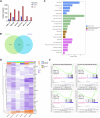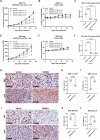Hypermethylation of CDKN2A CpG island drives resistance to PRC2 inhibitors in SWI/SNF loss-of-function tumors
- PMID: 39500892
- PMCID: PMC11538500
- DOI: 10.1038/s41419-024-07109-3
Hypermethylation of CDKN2A CpG island drives resistance to PRC2 inhibitors in SWI/SNF loss-of-function tumors
Abstract
Polycomb repressive complex 2 (PRC2) catalyzes the writing of the tri-methylated histone H3 at Lys27 (H3K27me3) epigenetic marker and suppresses the expression of genes, including tumor suppressors. The function of the complex can be partially antagonized by the SWI/SNF chromatin-remodeling complex. Previous studies have suggested that PRC2 is important for the proliferation of tumors with SWI/SNF loss-of-function mutations. In the present study, we have developed an EED-directed allosteric inhibitor of PRC2 termed BR0063, which exhibits anti-proliferative properties in a subset of solid tumor cell lines harboring mutations of the SWI/SNF subunits, SMARCA4 or ARID1A. Tumor cells sensitive to BR0063 exhibited several distinct phenotypes, including cell senescence, which was mediated by the up-regulation of CDKN2A/p16. Further experiments revealed that the expression of p16 was suppressed in the BR0063-resistant cells via DNA hypermethylation in the CpG island (CGI) promoter region, rather than via PRC2 occupancy. The expression of TET1, which is required for DNA demethylation, was found to be inversely correlated with p16 CGI methylation, and this may serve as a biomarker for the prediction of resistance to PRC2 inhibitors in SWI/SNF LOF tumors.
© 2024. The Author(s).
Conflict of interest statement
The authors declare no competing interests.
Figures






Similar articles
-
PRC2-mediated repression of SMARCA2 predicts EZH2 inhibitor activity in SWI/SNF mutant tumors.Proc Natl Acad Sci U S A. 2017 Nov 14;114(46):12249-12254. doi: 10.1073/pnas.1703966114. Epub 2017 Oct 30. Proc Natl Acad Sci U S A. 2017. PMID: 29087303 Free PMC article.
-
SWI/SNF mediates polycomb eviction and epigenetic reprogramming of the INK4b-ARF-INK4a locus.Mol Cell Biol. 2008 May;28(10):3457-64. doi: 10.1128/MCB.02019-07. Epub 2008 Mar 10. Mol Cell Biol. 2008. PMID: 18332116 Free PMC article.
-
SWI/SNF-mutant cancers depend on catalytic and non-catalytic activity of EZH2.Nat Med. 2015 Dec;21(12):1491-6. doi: 10.1038/nm.3968. Epub 2015 Nov 9. Nat Med. 2015. PMID: 26552009 Free PMC article.
-
Potential of enhancer of zeste homolog 2 inhibitors for the treatment of SWI/SNF mutant cancers and tumor microenvironment modulation.Drug Dev Res. 2021 Sep;82(6):730-753. doi: 10.1002/ddr.21796. Epub 2021 Feb 9. Drug Dev Res. 2021. PMID: 33565092 Review.
-
PRC2 and SWI/SNF Chromatin Remodeling Complexes in Health and Disease.Biochemistry. 2016 Mar 22;55(11):1600-14. doi: 10.1021/acs.biochem.5b01191. Epub 2016 Feb 17. Biochemistry. 2016. PMID: 26836503 Review.
References
MeSH terms
Substances
LinkOut - more resources
Full Text Sources
Miscellaneous

